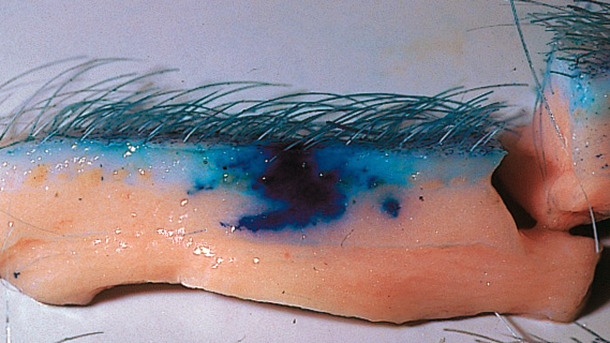In this second part of a series on transdermal vaccination, I will emphasize vaccine responses and particularly porcine respiratory and reproductive syndrome virus (PRRSV) vaccination. Since PRRSV infections like most viral infections are the result of infection of the lining (mucosa) of the respiratory tract, developing a strong mucosal response will help prevent PRRSV from establishing infections. There are two types of techniques that enhance this mucosal response: mucosal administration and transdermal administration. In both cases the adjuvat with the vaccine is important for obtaining a mucosal response. With the use of a transdermal device (TD), there is an enhanced dispersion of the vaccine that affects the animal’s immune response to an antigen. Traditional needle-syringe administration results in a bolus forming in the tissue adjacent to the tip of the needle. Needle-free injection technology improves the dispersion of vaccines throughout the tissue (Figure 1).


Figure 1: Distribution of methylene blue in the skin and underlying tissue following injection with a needle-free injection device. Distribution will vary by type of device, injection site, thickness of the skin, viscosity of the liquid, and pressure.
Reprinted with permission from Reed Business.
As the fluid stream forces its way through the tissue, it follows the path of least resistance, resulting in a widely dispersed, spider-web-like distribution of vaccine. The lower force in the dispersion phase allows the fluid to disperse in the tissue. This wide dispersion of vaccine is thought to increase exposure of the antigen to antigen-presenting cells, thereby resulting in an enhanced immune response. TD delivery has no effect on the antigenic component. Theoretically, vaccine delivery via the small needle-free orifice could damage the vaccine’s antigenic component via nicking or degradation, thereby altering its antigenicity. Transdermal vaccine delivery resulted in an enhanced immune response, when compared to traditional needle-and-syringe vaccine delivery. This includes enhanced antibody and enhanced cellular immune responses, which is antigen dependent. There have been over 40 vaccine studies with transdermal devices in swine. Results indicate an equivalent or better immune response with transdermal vaccination when compared with intramuscular vaccination with syringe-needle devices. No studies indicated a poorer response when TD was used.
There have been several developments with transdermal devices and PRRSV vaccines since the 2008 review. In the 2008 review, there were three studies that demonstrated that TD vaccination was as effective as needle syringe injections. There are two modified live PRRSV vaccines licensed in Europe for use with transdermal devices. Both vaccines use their own unique delivery devices. Two papers comparing intramuscular (IM) needle administration to transdermal (TD) administration of PRRSV vaccines resulted in a similar immune response to IM administered vaccines (Martelli, P, et al. 2007; 2009). More importantly, protection was seen against a heterologous PRRSV challenge at a similar rate between the two routes using the same amount of antigen but with 1/10 the volume of vaccine being administered by the TD route. Additionally there was a reduction in coughing and listlessness in the pigs vaccinated TD compared to the IM pigs following PRRSV challenge (Martelli, P, et al. 2009). Non-peer reviewed work with TD PRRSV vaccines also indicated heterologous protection and extended duration of immunity following challenge at 24 weeks of age compared to IM administered PRRSV vaccines. New experimental vaccines using PRRSV DNA vaccines administered using TD devices have also been effective at protection (Suradhat, S., 2016). In summary TD vaccination against PRRSV offers a similar to improved efficacy using 1/10 dose of vaccine as compared to IM MLV PRRSV vaccine. TD vaccination is an effective reproducible method to provide PRRSV protection.








